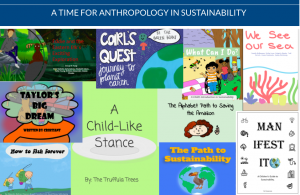2 Children’s Storybook
Cady Gonzalez
Course: Anthropology of Sustainability (ANT 2402)
Description
Students create a 10-15 page children’s storybook that answers a framing question pertaining to the course. Example: Write a book that answers the question, “What is sustainability?” from an anthropological perspective.
Assignment Goals/ Outcomes
- Recall, evaluate, employ and synthesize influential concepts and concerns discussed in the course
- Distill and communicate theoretical and/or abstract concepts into everyday language
- Provide a springboard for conversation
- Promote a vocabulary, an ethic and/or a learning experience that empower readers (both young and old)
Assignment Setup (Instructor)
Once groups are set-up in Canvas, create a group assignment. Provide directions to students on the description of the assignment. Submissions should be in PDF format.
Student Instructions
Plan, write and illustrate a 10-15 page children’s storybook that answers the following question: _____.
Required Components

- Cover Page – includes the title of the book and an illustration that relates to the story
- Illustrations – original artwork for each page; must present the plot throughout all areas of the book
- Text – clearly communicates the book’s message, uses proper grammar and spelling, and employs literary devices
- Plot Development – the book provides a thoughtful, creative reflection and critical analysis of the prompt and all five areas of the plot (exposition, rising action, climax, falling action and resolution) are present and clearly developed
- This is a group project and requires one submission per team
Resources & Worksheets
Helpful resources and worksheets can be found Canvas. Note that not all of these will be applicable to every story.
- Concept Map – This is important for everyone. Working through this worksheet will help you and your team keep the core theme/topic in view and ensure that every element of the book re-enforces this message.
- Plot Pitch Template – Will assist to structure and organize the text of your story in ~14 pages.
- Narrative Pyramid – This relates the development of each character to the overall plot.
Additional Considerations
Remember to ask, “Who is my audience?”
Conflict/Problem:
- How does your story address the framing question / prompt? Think about using a particular story to speak to a general or larger concern.
- What is at stake? In other words, what is the main problem that the characters face in the book?
- What is the resolution you propose?
Text & Illustrations
- The text should be organized into simple sentences and/or short paragraphs.
- Consider employing literary tools to help make the story more vivid and move forward (i.e. rhythm, alliteration, repetition, refrains, onomatopoeia, rhyme, posing questions). Repeating elements can also serve as a narrative tool to express a motif or theme important to your story.
- Illustrations are effective to the development of the story as a whole. Front covers should represent the story (i.e. presents the main conflict or point).
- For each character: what is the trait of the story’s character that you want to make easily identifiable, sympathetic, or dominant?
- What character trait of the main character will you established through the text?
- What character trait of the main character will you established through the illustrations
Grading (Instructor/TA)
Final class presentations are completion only.
Tips & Suggestions for Other Instructors
Team-Based Learning
This assignment is particularly effective in a course employing team-based learning. According to students, the success of their projects is directly related to the continuity in their teams over the semester. Teams should be curated at the beginning of the course and remain unchanged so that there is as much diversity as possible within groups. Consider the following when breaking students into teams:
- leadership preference (follower or leader)
- expertise in subject (major, minor, number of classes, etc)
- level of creativity (visually artistic, poetic, creative writing, etc)
Essay
Accompany this group final project with an individual 3-5 page essay that requires each student to illustrate their own knowledge of subject matter. This reflection may:
- answer the framing question posed for the story book in their own words
- explicitly state the objective of the storybook
- specifically and clearly explain how course material was applied in the creation of the storybook
- outline their contribution to the final group project
Keywords: creation, storybook, illustration, framing question, team-based learning (TBL)
